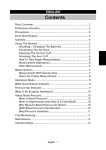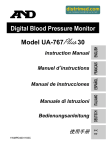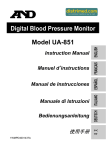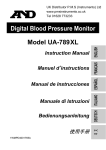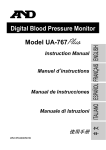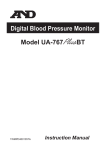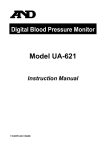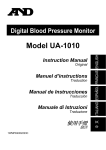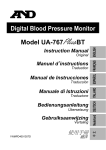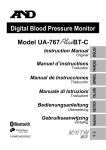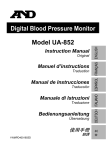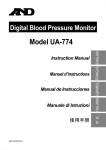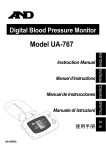Download A&D UA-767 Plus 30 Instruction manual
Transcript
Digital Blood Pressure Monitor Model UA-767 30 Instruction Manual Manuel d’instructions Manual de Instrucciones Manuale di Istruzioni Bedienungsanleitung 使用手册 WM+PD4001183 33 Contents Dear Customers.................................................................... 2 Preliminary Remarks ............................................................. 2 Precautions........................................................................... 2 Parts Identification................................................................ 3 Symbols................................................................................ 4 Operation Mode.................................................................... 5 1. Normal Measurement With Storing Data ..................... 5 2. Recalling Data.............................................................. 5 3. Clearing Data............................................................... 5 4. Measurement With The Desired Systolic Pressure ......... 5 Using the Monitor ................................................................. 6 Installing / Changing The Batteries .................................. 6 Connecting The Air Hose ................................................. 6 Selecting The Correct Cuff ............................................... 6 Attaching The Arm Cuff ................................................... 7 How To Take Proper Measurements ................................... 7 Measurement ................................................................... 7 After Measurement .......................................................... 7 Measurements ...................................................................... 8 Normal Measurement....................................................... 8 Measurement With The Desired Systolic Pressure ............. 9 Notes For Proper Measurement ........................................ 9 What Is An Irregular Heartbeat ............................................ 10 Pressure Bar Indicator ......................................................... 10 WHO Classification Indicator ............................................... 10 About Blood Pressure.......................................................... 11 What Is Blood Pressure? ................................................. 11 What Is Hypertension And How Is It Controlled? ............. 11 Why Measure Blood Pressure At Home? .......................... 11 WHO Blood Pressure Classification ................................. 11 Blood Pressure Variations............................................... 11 Troubleshooting ................................................................. 12 Maintenance ....................................................................... 13 Technical Data .................................................................... 13 English 1 Dear Customers Congratulations on purchasing a state-of-the-art A&D blood pressure monitor, one of the most advanced monitors available today. Designed for ease of use and accuracy, this monitor will facilitate your daily blood pressure regimen. We recommend that you read through this manual carefully before using the device for the first time. Preliminary Remarks This device conforms to the European Directive 93/42 EEC for Medical mark of conformity. Products. This is made evident by the (0366: The reference number of the designated authority). The device is designed for use on adults only, not newborns or infants. Environment for use The device is for use indoors. Precautions Precision components are used in the construction of this device. Extremes in temperature, humidity, direct sunlight, shock or dust should be avoided. Clean the device with a soft, dry cloth. Never use thinner, alcohol, benzine, or wet cloth. Avoid tightly folding the cuff or storing the hose tightly twisted for long periods, as such treatment may shorten the life of the components. The device and cuff are not water resistant. Prevent rain, sweat and water from soiling the device and cuff. Measurements may be distorted if the device is used close to televisions, microwave ovens, cellular telephones, X-ray or other devices with strong electrical fields. Used equipment, parts and batteries are not treated as ordinary household waste, and must be disposed of according to the applicable local regulations. English 2 Parts Identification DC Jack START button (Orange illumination) Display Air Connector Plug Air Socket Arm Cuff Air Hose Proper Fit Range Battery Cover Index Mark Battery Compartment 1.5V Batteries (R6P, LR6 or AA) Part of Display MEMORY Pressure Bar Indicator and WHO Classification Indicator Systolic Pressure Diastolic Pressure Pulse Rate Battery Indicator I.H.B. Indicator (Irregular heartbeat indicator) English 3 Heart Mark Symbols Symbols Function / Meaning Recommended Action Standby and Turn the device on. Battery installation guide Direct current SN Serial number Date of manufacture Type BF: Device, cuff and tubing are designed to provide special protection against electrical shocks. The indicator while measurement is in Measurement is in progress. It blinks while detecting the progress. Remain as still pulse. as possible. Irregular Heartbeat indicator. (I.H.B.) The indicator that detects irregular heartbeats or any excessive body movement during the measurement. Previous measurements stored in MEMORY. The battery power indicator during Full Battery measurement. Replace all batteries with new ones, when the Low Battery The battery is low when it blinks. indicator blinks. Try measurement again. Unstable blood pressure due to Remain very still during movement during the measurement. the measurement. The systolic and diastolic values are within 10 mmHg of each other. The pressure value did not increase Fasten the cuff correctly, during inflation. and try the measurement again. The cuff is not fastened correctly. PUL. DISPLAY ERROR SYS DIA PUL./min The pulse is not detected correctly. Systolic blood pressure in mmHg Diastolic blood pressure in mmHg. Pulse per minute EC directive medical device label WEEE label English 4 Operation Mode 1. Normal Measurement With Storing Data ( Refer to page 8) Press the START button. Blood pressure is measured and data is stored within the device. The device can store the last thirty sets of data in memory automatically. 2. Recalling Data Press and hold the START button to recall the data. Stored data are automatically displayed in order from the last data. The device can store the last thirty sets of data in memory automatically. Press and hold Data number Alternation Stored Data 3. Clearing Data Remove batteries to clear all data. Re-install them again. 4. Measurement With The Desired Systolic Pressure Refer to page 9 for the measurement with the desired systolic pressure. English 5 Using the Monitor Installing / Changing The Batteries Step 1 1. Slide the battery cover up to open it. 2. Remove the used batteries and insert new batteries into the battery compartment as shown, taking care that the polarities (+) and (-) are correct. 3. Slide the battery cover down to close it. Use only R6P, LR6 or AA batteries. Step 3 Step 2 CAUTION Insert the batteries as shown in the battery compartment. If not, the device will not work. When (LOW BATTERY mark) blinks in the display, replace all batteries with new ones. Do not mix old and new batteries. It may shorten the battery life, or cause the device to malfunction. (LOW BATTERY mark) does not appear when the batteries are drained. Battery life varies with the ambient temperature and may be shorter at low temperatures. Use the specified batteries only. The batteries provided with the device are for testing monitor performance and may have a limited life. Remove the batteries if the device is not to be used for a long time. The batteries may leak and cause a malfunction. Air Hose Stored data are cleared when the batteries are removed. Connecting The Air Hose Insert the air connector plug into the air socket firmly. Air Connector Plug Air Socket Selecting The Correct Cuff Using the correct cuff size is important for an accurate reading. If the cuff is not the proper size, the reading may yield an incorrect blood pressure value. The index and proper fit range, on the cuff, tell you if you are attaching the correct cuff. (Refer to "Attaching The Arm Cuff" on next page) If the index points outside of the range, contact your local dealer for replacement. Arm Size Recommended Cuff Size 32 cm to 42 cm Large cuff 22 cm to 32 cm Medium cuff 18 cm to 22 cm Small cuff Arm size: The circumference at the biceps. English 6 Order No. UA-CUFDBKLA-EC UA-CUFDBKAU-EC UA-CUFDBKCH-EC Using the Monitor Rolled up shirtsleeve Attaching The Arm Cuff 1. Wrap the cuff around the upper arm, about 2 - 3 cm above the elbow, as shown. Place the cuff directly against the skin, as clothing may cause a faint pulse and result in a measurement error. 2. Constriction of the upper arm, caused by rolling up a shirtsleeve, may prevent accurate readings. 3. Confirm that the index the proper fit range. Cuff Air Hose 2 -3 cm Constriction of the Upper Arm points within How To Take Proper Measurements For the most accurate blood pressure measurement: Sit comfortably around the table. Index and Proper fit range Rest your arm on the table. Relax for about five to ten minutes before measurement. Place the center of the cuff at the same height as your heart. Remain still and keep quiet during measurement. Do not measure right after physical exercise or a bath. Rest for twenty or thirty minutes before taking the measurement. Try to measure your blood pressure at the same time every day. Measurement During measurement, it is normal for the cuff to feel very tight. (Do not be alarmed) After Measurement After measurement, press the START Remove the cuff and record your data. button to turn off the power. Note: The device has an automatic power shut-off function, which turns the power off approximately one minute after measurement. Allow at least ten minutes between measurements on the same person. English 7 Measurements Model UA-767 30 is designed to detect the pulse and to inflate the cuff to a systolic pressure level automatically. If your systolic pressure is expected to exceed 230 mmHg or you use the optional small cuff, read "Measurement With The Desired Systolic Pressure" on next page. Normal Measurement 1. Place the cuff on the arm (preferably the left arm). At heart level Sit quietly during measurement. 2. Press the START button. The average blood pressures and last data number are displayed briefly. Then the display changes, as indicated in the figure at the right, as the measurement begins. The cuff starts to inflate. It is normal for the cuff to feel very tight. A pressure bar indicator is displayed, as in the figure at the right, during inflation. Note: If you wish to stop inflation at any time, press the START button again. 3. When inflation is complete, deflation starts automatically and the (heart mark) blinks, indicating that the measurement is in progress. Once the pulse is detected, the mark flashes with each pulse beat. Note: If an appropriate pressure is not obtained, the device starts to inflate again automatically. 4. 5. When the measurement is complete, the systolic and diastolic pressure readings and pulse rate are displayed. The cuff exhausts the remaining air and deflates completely. Press the START off the power. button again to turn START button Averaged data Data number Starts inflation Pressurizing Measurement in progress Systolic pressure Diastolic pressure WHO classification Pulse rate Exhausts remaining air automatically Note: Model UA-767 30 is provided with an automatic power shut-off function. Allow at least ten minutes between measurements on the same person. English 8 Measurements Measurement With The Desired Systolic Pressure If your systolic pressure is expected to exceed 230 mmHg or you use the optional small cuff, use this procedure. 1. Place the cuff on the arm (preferably the left arm). 2. Press and hold the START button until a number about 30 to 40 mmHg higher than your expected systolic pressure appears. 3. Release the START button to start measurement, when the desired number is reached. Then continue to measure your blood pressure as described on the previous page. At heart level Press and hold the button Release the button at the desired systolic pressure Refer to the previous page for measurement Notes For Proper Measurement Sit down in a comfortable position. Place the arm to be used for the measurement on a table or other support so that the center of the cuff will be at the same height as your heart. Relax for about five or ten minutes before taking a measurement. If you are excited or depressed by emotional stress, the measurement will reflect this stress as a higher (or lower) than normal blood pressure reading and the pulse reading will usually be faster than normal. An individual's blood pressure varies constantly, depending on what you are doing and what you have eaten. What you drink can have a very strong and rapid effect on your blood pressure. This device bases its measurements on the heartbeat. If you have a very weak or irregular heartbeat, the device may have difficulty determining your blood pressure. Should the device detect a condition that is abnormal, it will stop the measurement and display an error symbol. See page 4 for the description of symbols. This blood pressure monitor is intended for use by adults only. Consult with your physician before using this device on a child. A child should not use this device unattended. English 9 What Is An Irregular Heartbeat Model UA-767 30 blood pressure monitor provides a blood pressure and pulse rate measurement even when an irregular heartbeat occurs. An irregular heartbeat is defined as a heartbeat that varies by 25% from the average of all heartbeats during the blood pressure measurement. It is important that you be relaxed, remain still and do not talk during measurements. Note: We recommend contacting your physician if you see this indicator frequently. Pressure Bar Indicator The indicator monitors the progress of pressure during measurement. Pressurizing Inflation in progress Releasing air Measurement in progress Inflation complete WHO Classification Indicator Each six segments of the bar indicator correspond to the WHO blood pressure classification described on the next page. WHO Classification Indicator Severe hypertension Moderate hypertension Mild hypertension High normal Normal Optimal Moderate hypertension Mild hypertension : The indicator displays a segment, based on the current data, corresponding to the WHO classification. English Example: 10 High normal About Blood Pressure What Is Blood Pressure? Blood pressure is the force exerted by blood against the walls of the arteries. Systolic pressure occurs when the heart contracts. Diastolic pressure occurs when the heart expands. Blood pressure is measured in millimeters of mercury (mmHg). One's natural blood pressure is represented by the fundamental pressure, which is measured first thing in the morning while one is still at rest and before eating. What Is Hypertension And How Is It Controlled? Hypertension, an abnormally high arterial blood pressure, if left unattended, can cause many health problems including stroke and heart attack. Hypertension can be controlled by altering lifestyle, avoiding stress, and with medication under a doctor’s supervision. To prevent hypertension or keep it under control: Do not smoke Exercise regularly Reduce salt and fat intake Have regular physical checkups Maintain proper weight Why Measure Blood Pressure At Home? Blood pressure measured at a clinic or doctor's office may cause apprehension and can produce an elevated reading, 25 to 30 mmHg higher than that measured at home. Home measurement reduces the effects of outside influences on blood pressure readings, supplements the doctor's readings and provides a more accurate, complete blood pressure history. WHO Blood Pressure Classification Standards to assess high blood pressure, without regard to age, have been established by the World Health Organization (WHO), as shown in the chart . Blood Pressure Variations An individual’s blood pressure varies greatly on a daily and seasonal basis. It may vary by 30 to 50 mmHg due to various conditions during the day. In hypertensive individuals’ variations are even more pronounced. Normally, the blood pressure rises while at work or play and falls to its lowest levels during sleep. So, do not be overly concerned by the results of one measurement. Take measurements at the same time every day using the procedure English 11 described in this manual to get to know your normal blood pressure. Regular readings give a more comprehensive blood pressure history. Be sure to note date and time when recording your blood pressure. Consult your doctor to interpret your blood pressure data. Troubleshooting Problem Possible Reason Nothing Batteries are drained. appears in the display, even Battery terminals are not when the power in the correct position. is turned on. The cuff does not inflate. The unit does not measure. Readings are too high or too low. Other Battery voltage is too low. (LOW BATTERY mark) blinks. [ If the batteries are drained completely, the mark does not appear.] The cuff is not fastened properly. You moved your arm or body during the measurement. Recommended Action Replace all batteries with new ones. Reinstall the batteries with negative and positive terminals matching those indicated on the battery compartment. Replace all batteries with new ones. Fasten the cuff correctly. Make sure you remain very still and quiet during the measurement. Sit comfortably and still. Raise your hand so that the cuff is at the same level as your heart. If you have a very weak or irregular heat beat, the device may have difficulty in determining your blood pressure. The cuff position is not correct. The value is different from that measured at a clinic or doctor’s office. See “Why measure blood pressure at home”. Remove the batteries. Place them back properly and try the measurement again. Note: If the actions described above do not solve the problem, contact the dealer. Do not attempt to open or repair this product, as any attempt to do so will make your warranty invalid. English 12 Maintenance Do not open the device. It uses delicate electrical components and an intricate air unit that could be damaged. If you cannot fix the problem using the troubleshooting instructions, request service from your dealer or from the A&D service group. The A&D service group will provide technical information, spare parts and units to authorized dealers. The device was designed and manufactured for a long service life. However it is generally recommended to have the monitor inspected every 2 years, to ensure proper functioning and accuracy. Please contact either your authorized dealer or A&D for maintenance. Technical Data Type Measurement method Measurement range UA-767 30 Oscillometric measurement Pressure: 20 - 280 mmHg Pulse: 40 - 200 beats / minute Measurement accuracy Pressure: ±3 mmHg or 2%, whichever is greater Pulse: ±5% Power supply 4 x 1.5V batteries (R6P, LR6 or AA) Upper arm circumference 22 - 32 cm Classification Type BF Clinical test According to ANSI / AAMI SP-10 1987 EMC IEC 60601-1-2: 2001 Memory Last 30 measurements Operating condition +10°C to +40°C / 30%RH to 85 %RH Storage condition -10°C to +60°C / 30%RH to 85 %RH Dimensions Approx. 147 [W] x 64 [H] x 110 [D] mm Weight Approx. 300 g, excepting batteries Note: Specifications are subject to change without prior notice. English 13















